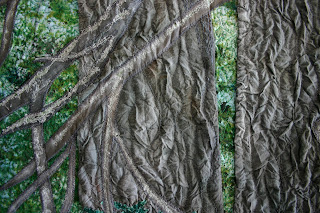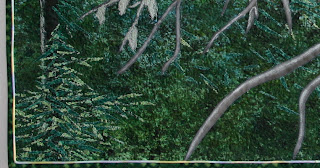Week 2 – Quilt 2
Boreal Forest
I've chosen a quilt made more recently to show you the direction I seem to be going now. Art quilting more so than the traditional, although I still really enjoy piecing every once in a while and playing with lots of colour.
Inspiration photo
The inspiration for Boreal Forest was this photo, taken while out on one of my walks down our country road. These species are black spruce trees and represent a large portion of the Boreal Forest population.
I hand painted the background on white cotton using Gloria Loughman's techniques.
First painted the sky backdrop with textile paint, let it dry and set with hot iron.
Next came the sponging and painting of the background trees.
Work in progress
Once the paint was dry and set again, the piece was ready for the appliqued trees and branches.
trunk detail
I wetted some of my own hand dyed fabric , scrunched and wrapped it with elastic bands and threw it in the dryer with a load of clothes. Once dry, I had bark for my two trees. After the branches were added, I painted, stitched and added dyed cheesecloth moss.
moss detail
Snippets formed the little tree in the left corner as well as some needed texture to the undergrowth.
snippet detail
The background quilting on this quilt is an all over angled type of stippling (straight lines instead of curved) and the bark was free motioned with a random wiggly design.
quilt back
I piped the edge of the binding and painted the back of the quilt, a little surprise on the back is always fun.
Boreal Forest was juried into the 2010 Pacific International Quilt Festival XIX.
Judges comments:
Great use of multiple techniques that combine well into a cohesive scene.
Back design noted and appreciated.
Binding piping well done.
I was very happy with those comments and even though the quilt did not place, just being juried in was very exciting. I was lucky enough to be able to attend the Quilt Festival in Santa Clara. What a show!
Also got to spend a few days in San Francisco which has been on my bucket list for a long time and I was not disappointed.
Even with an overcast sky and a little cool -13˚C (8˚F),
it's still a nice day in Kenogami.
Have a great day!
Terry
+++++++++++++++++++++++++++++++++++++++++++++++++++++++++++++++++
Here's the documentation for Boreal Forest:
Quilt Name: Boreal Forest
Description: Tree landscape using colour and design to create depth and threadplay and layering of fabric for texture: hand painting on ground. (Description from Appraiser)
Pattern: Landscape
Size: 34” x 29”
Fabrics: 100% cotton, hand painted background, hand dyes, cheesecloth, tulle
Predominant colours: Brown, green, blue, white
Construction Techniques: Machine quilting threadplay, scrunched technique, hand painting
Back: 100% cotton
Batting: Bamboo
Edge finish: French fold 2 ½” binding, machine applied front, hand on back with mitered corners, 1/8” piping
Quilting:All over angled stippling and directional free motion on trees
Quilted by: domestic machine by Terry Whyte
Sleeve: Yes
Label: Yes
Date completed: April 2010
Inspiration: Photo taken by Terry Whyte
Appraised: Yes, insurance replacement value $600. Cdn
Quilt History: Juried into Pacific International Quilt Festival XIX, October14-17, 2010
Maker: Terry Whyte






























